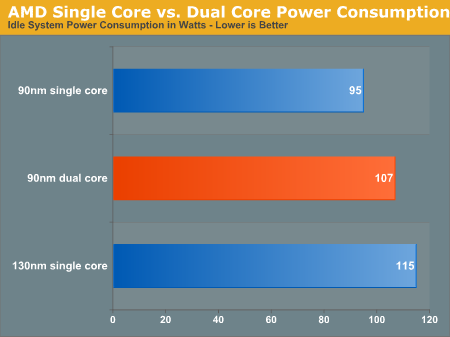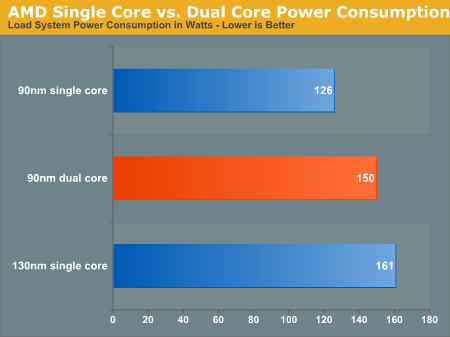AMD's Athlon 64 X2 4800+ & 4200+ Dual Core Performance Preview
by Anand Lal Shimpi on May 9, 2005 12:02 AM EST- Posted in
- CPUs
Power Consumption: Athlon 64 vs. Athlon 64 X2
In Part II of our preview of Intel's dual core processors, we noted that the addition of a second CPU core generally didn't increase overall system power consumption by that much. In fact, the Pentium D 2.8GHz vs. single core 2.8GHz comparison yielded only a 15% increase in system power consumption under load for the dual core CPU. While we didn't look at power consumption in our dual core Opteron review, armed with desktop parts, we were ready to look at how desktop power consumption was affected by the move to dual core.Single core AMD CPUs have always consumed less power than single core Intel chips; in fact, the 130nm Athlon 64 FX-55 consumes less power than a 3.0GHz Pentium 4 (5xx or 6xx series).
How much more power would a dual core Athlon 64 X2 consume? To answer this question, we looked at three CPUs on the same platform and measured system power consumption. We used a 130nm Athlon 64, a 90nm Athlon 64 and a 90nm dual core Athlon 64 X2 - all clocked at the same frequency and with the same per-core cache sizes. The results are below:


If you're worried about the Athlon 64 X2 generating too much heat, there's no reason to be concerned - if you're happy with the heat levels of your current 130nm Athlon 64, the X2 will run even cooler.










109 Comments
View All Comments
DrMrLordX - Monday, May 9, 2005 - link
#9, I found it a little odd as well, but keep in mind that, not too long ago, Intel was still winning multimedia and 3d rendering benches on a regular basis with Northwood and Prescott. This might explain why Intel won narrow victories in some of the in-house multitasking benchmarks.What is clear is that the X2 is the superior processor when it comes to running lone multithreaded applications.
The X2 is useful for anyone, while the Pentium D will only shine for people with distinctive usage patterns. Too bad the X2 costs so much.
Zebo - Monday, May 9, 2005 - link
#9 every REAL WORLD AMD wins. I don't even look at synthetics or contrived benches so someone else maybe tells you if Intel won one.:) They tend to do really well in those.Zebo - Monday, May 9, 2005 - link
Total domination too bad I can't get one now!!!Anand what memory timings and CMD rate used in this review?
Frew - Monday, May 9, 2005 - link
Is overclocking the same with a dual core cpu?reactor - Monday, May 9, 2005 - link
good article, cant wait to see how yonah stacks up so i can make a decision on what to get.btw the graphs all say intel pentium D 840, instead of 640.
Aenslead - Monday, May 9, 2005 - link
Is it just me, or did AMD win in EVERY benchmark program? Simply amazing.Still, it surprises me to see intel push ahead on multitasking by a tad.
Swaid - Monday, May 9, 2005 - link
I hate the price of admission!anandtechrocks - Monday, May 9, 2005 - link
Amazing preformance, but half a G is really pushing it for a processor...Capt Caveman - Monday, May 9, 2005 - link
I hate that we have to wait til Q3/Q4.Brian23 - Monday, May 9, 2005 - link
While I'm very impressed by this IC, I hate paper launches.